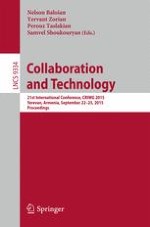2015 | Buch
Collaboration and Technology
21st International Conference, CRIWG 2015, Yerevan, Armenia, September 22-25, 2015, Proceedings
herausgegeben von: Nelson Baloian, Yervant Zorian, Perouz Taslakian, Samvel Shoukouryan
Verlag: Springer International Publishing
Buchreihe : Lecture Notes in Computer Science
